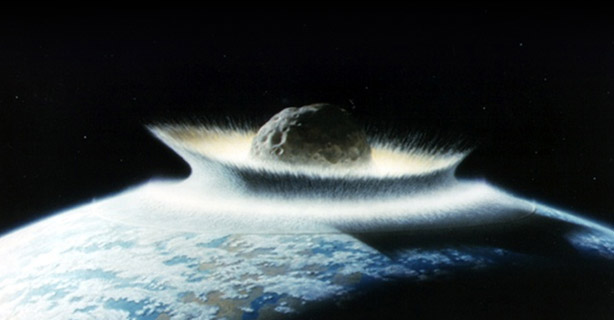
This is an artist's conception of an impact. But that is a much bigger rock than anything that's hit Earth in a very long time. Even the "dinosaur" killer was tiny compared to this illustration (more on that below).
The Earth has been getting hit by asteroids and comets for its whole life. The planets formed from collisions of smaller objects, and even our water may have come largely from comets. Heavy bombardments may have continued until as recently as 4 billion years ago, making it difficult for life to get a foothold at all (the "Late Heavy Bombardment").
There are a lot more small rocks than big ones. So while Earth is constantly being "hit" -- accumulating over 100 tons of matter ever day -- most of this is in the form of dust or tiny sand-grain sized meteors that appear as shooting stars. By comparison, school bus-sized asteroids may hit every thousand years or so, medium sized (say 300 meter) asteroids might be once every 50,000 years, and extinction level events only every billion years. And those estimates are going down.
The Spaceguard Survey is an attempt to locate and track as many near-Earth objects (NEOs) as possible. Each time astronomers identify an asteroid that isn't on a collision course with Earth, the calculated odds of an impact go down a little bit. By the time the current survey is completed the estimated odds of dying in an asteroid impact will have decreased by a factor of 10, from 1 in 70,000 to 1 in 700,000. Assuming, of course, that they don't find one that really is going to hit.
People tend to think that an "extinction level" asteroid or comet would look like the picture at the top of the page. But in reality it could be very, very small compared to Earth. The "dino killer" is estimated to have been between 5 and 15 kilometers across (3 to 10 miles). That's large compared to the rocks in your backyard, but tiny compared to Earth (check out the image on the right to see just how small it would be).
To lead to a global catastrophe, an asteroid or comet only has to be big enough to launch large amounts of dust in to the atmosphere. That leads to the abrupt change in climate that wipes out species.
The odds of a major asteroid impact are very small. But the risk of you dying in an asteroid impact might be higher than you think. Why? Because while the odds of an impact are small, the number of people who would be killed is so high that the risk (impact odds times the number killed) isn't negligible. Check out our risk game and see how those odds compare to other risks.
Apophis is an asteroid about 270 meters across (almost three football fields). In 2029 it will pass very close to the Earth: within the orbits of our communication satellites. It won't hit; however there is a slight chance that this close pass will shift its orbit exactly the right amount to cause it to hit Earth on a second pass in 2036. The odds are small though: as of 2009 the odds are estimate at 1 in 250,000, but that estimate will continue to be refined.


 Lorem ipsum dolor sit amet, consectetur adipisicing elit,
sed do eius tempor incididunt ut labore.
Lorem ipsum dolor sit amet, consectetur adipisicing elit,
sed do eius tempor incididunt ut labore.
Lorem ipsum dolor sit amet, consectetur adipisicing elit, sed do eius tempor incididunt ut labore et dolore magna aliqua. Ut enim ad minim veniam, quis nostrud exercitation ullamco laboris Nullam pulvinar ultri malasuada quisque.
Lorem ipsum dolor sit amet | Learn more about all we can offer